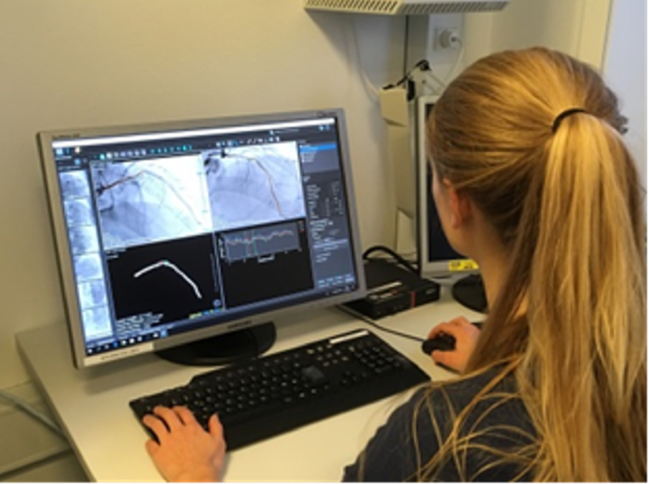Deferred Revascularization Safer When Guided by FFR vs QFR: FAVOR III Europe
The subanalysis points to the possibility that it’s not just false positives—but false negatives—driving MACE with QFR.

Adapted from: Andersen BK. Quantitative flow ratio or fractional flow reserve for guiding coronary revascularization. Presented at: TCT 2024. Washington, DC.
Patients whose coronary revascularization is deferred based on the results of quantitative flow ratio (QFR) develop more major adverse cardiovascular events over the next year than if the wait-and-see decision is based on fractional flow reserve (FFR), according to post hoc analysis of the FAVOR III Europe trial.
The difference was mainly driven by the need for urgent revascularization, researchers report in a paper published recently in EuroIntervention.
When presented last October at TCT 2024, the trial’s main results sparked much discussion—its comparison of the two modalities, looking at both deferred and immediate cases, showed QFR did not meet noninferiority criteria compared with FFR for 1-year MACE. Those data called into question the recent excitement over QFR’s role as an alternative to FFR, which has long had support from both US and European guidelines.
Lead author Birgitte K. Andersen, MD (Aarhus University Hospital, Denmark), told TCTMD that this latest analysis suggests that the mechanisms behind their earlier findings aren’t straightforward. At the time, some suggested that the imbalance in MACE rate stemmed from more false positives with QFR—21% more patients were revascularized in the QFR group, with a 27% increase in the number of stents compared with FFR.
Their new report “adds some extra worry, because it’s not only that [there is] excess treatment, but also that the deferred population is doing worse” when decisions were guided by QFR, said Anderson. Based on this analysis, she added, it appears false negatives might also be an issue.
William Fearon, MD (Stanford University School of Medicine, CA), who commented on the study for TCTMD, agreed that this is plausible. “This substudy suggests that there was an increased event rate in the group of patients which had deferral based on QFR,” he said. “In other words, there were significant lesions that should have received PCI, but did not based on QFR and then led to events.”
Wait-and-See in FAVOR III Europe
In FAVOR III Europe, at least one deferral of a study lesion occurred in 55.2% of the QFR group and 65.3% of the FFR group; within this subpopulation, 433 patients (82.8%) and 511 patients (85.3%) had a “complete” deferral, where all study lesions were deferred based on the QFR or FFR results, respectively.
Within the complete deferral group, 1-year MACE—all-cause death, MI, or unplanned coronary revascularization—occurred in 5.6% of those whose interventions had been deferred based on QFR and 2.8% of those where the decision was based on FFR (adjusted HR 2.07; 95% CI 1.07-4.03). Unplanned revascularization was the main endpoint driving the imbalance in MACE (3.7% with QFR vs 2.4% with FFR; adjusted HR 2.21; 95% CI 0.98-4.96).
Within the broader group with any deferral, the MACE rates did not significantly differ but followed a similar pattern: 5.6% with QFR and 3.6% with FFR (adjusted HR 1.55; 95% CI 0.88-2.73). Again, unplanned revascularization made the biggest impact on the combined endpoint.
The investigators also explored a hybrid “gray zone” strategy, which has been used in prior comparisons between FFR and instantaneous wave-free ratio (iFR). The approach sets a threshold—here, 0.85 for QFR—that ensures a high negative predictive value. With this limit, the 1-year MACE rates for deferred cases in FAVOR III Europe trended in the same direction as in the other analyses, revealing no added insights.
It’s unclear why QFR didn’t measure up to FFR in FAVOR III Europe, Andersen and colleagues note. “Differences in the performance of QFR and FFR may be related to the considerable differences in the nature of a pressure wire-based method and a computer-based method,” they write. “The latter may be less sensitive to patient-specific changes in, for example, microcirculation or identification of high-risk plaque.”
Given the central role of unplanned revascularization, they add, “the explanation may rather simply be the poorer performance of QFR, with too many clinically relevant false negatives in a clinical, multicenter setting, and the reliance on in-procedure QFR analysis.”
Fearon, in his email to TCTMD, delved into the various possibilities.
“The cynic would say that QFR is not as accurate as pressure wire-based physiology and is undercalling significant lesions and overcalling insignificant lesions, and both errors are leading to an increase in events,” he noted.
“The defender of QFR might say that there is something in the study design leading to the increase in events,” Fearon continued. “For example, it is not clear that the clinicians following the patients were blinded to which arm the patients were randomized to and may have been biased against QFR. If a patient in the QFR [arm] complained of noncardiac symptoms, they may have been more likely to bring them back to the cath lab and perform PCI on the intermediate lesion, even if the QFR was negative initially.”
When we do not have these large, randomized trials, we are not sure that [new technologies] are actually working well, even though we have positive early validation studies. Birgitte K. Andersen
Andersen, for her part, said there could be multiple factors impacting QFR’s performance, including the algorithm used to compute the results as well as the human beings who apply it in practice. “ There are major reproducibility issues with QFR. There are so many steps that require user interaction and each of these steps adds some possible differences between the observers,” she explained.
Next up, the investigators’ priority is to reanalyze data for all of the “QFR patients, and then later the FFR patients, to hopefully provide some more mechanistic insights,” added Andersen, who said they’re also looking to see if there are any vessel-specific or other explanations for events.
Fearon said it would be informative to see how well QFR and FFR values correlate in patients randomized to FFR-guided treatment in FAVOR III Europe.
Importantly, he stressed, QFR and other angiography-derived physiology tools aren’t all the same, thanks to their unique algorithms. This stands in contrast to technologies like iFR that employ nonhyperemic diastolic pressure ratio. The ALL-RISE trial of FFRangio- versus pressure wire-guided treatment has just wrapped up, said Fearon, who serves as its co-principal investigator. “This should be extremely informative about the future of angiography-derived physiology.”
Caitlin E. Cox is News Editor of TCTMD and Associate Director, Editorial Content at the Cardiovascular Research Foundation. She produces the…
Read Full BioSources
Andersen BK, Holm NR, Mogensen LJH, et al. Coronary revascularisation deferral based on quantitative flow ratio or fractional flow reserve: a post hoc analysis of the FAVOR III Europe trial. EuroIntervention. 2025;21:e1-e10.
Disclosures
- The FAVOR III Europe trial was funded in part by Medis Medical Imaging and Aarhus University.
- Andersen reports an institutional research grant from Medis Medical Imaging.
- Fearon reports serving as the co-PI of the ALL-RISE trial as well as previously consulting for CathWorks; currently consulting for ShockWave; receiving research support from CathWorks, Abbott, and Medtronic; and owning stock options with HeartFlow.





Comments